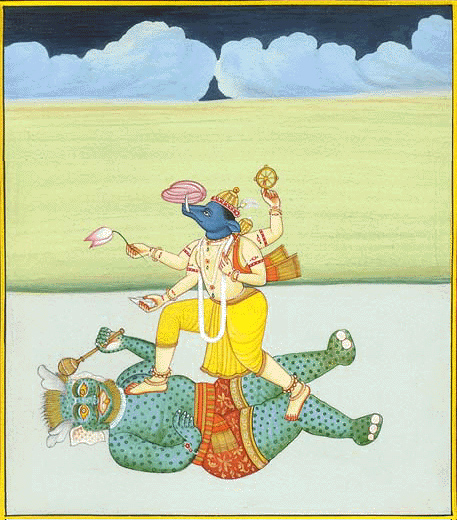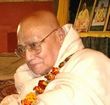 The third incarnation among the Ten Incarnations is Varaha avatara, or the Boar incarnation. The story of the lila-avataras has been discussed previously in the description of Matsya avatara.
The third incarnation among the Ten Incarnations is Varaha avatara, or the Boar incarnation. The story of the lila-avataras has been discussed previously in the description of Matsya avatara. When Brahmaji received the order to carry out the creation, he started thinking about the subject matters of creation. At that moment, a male named Svayambhuva Manu and a female named Satarupa manifested from his body. By the desire of Brahma, Svayambhuva Manu accepted Satarupa as his wife for the purpose of creation. Seeing the earth submerged in the water of annihilation and desiring to seek a dwelling place for the living beings, Manu approached his father Brahmaji and prayed to him to rescue the earth. When Brahmaji saw the earth submerged in the water, he thought for a long time about how it could be rescued. He had earlier established the earth after removing all the water but he could not understand why the earth had sunk into the water again. He had been appointed for the work of creation but the earth had become inundated in a deluge and had sunk down to the Rasatala planetary system. How was the creation to be done? How was the earth to be rescued?
Even after much effort, Brahmaji was not able to think of any solution. At last, he took shelter of the Supreme Lord Visnu. While Brahmaji was still deep in thought, a small boar the size of the tip of a thumb manifested from his nose. But the most surprising thing is that the small boar expanded in front of Brahmaji and within moments, filled the sky and assumed a form as big as an elephant. Brahma, together with the great brahmanas like Marici, as well as the Four Kumaras and Svayambhuva Manu saw the transcendental Varaha form and began to discuss among themselves. Lord Brahma thought that this was some denizen of the transcendental world in disguise; traveling in the form of a boar. Oh! What a great surprise! It is very wonderful that this expanding Varaha form has come out of my nostril. Is Sri Hari, the Lord of sacrifice, hiding His form and trying to agitate us?'
In this way, while Brahma was deliberating with his associates, Sri Hari roared tumultuously like the great mountain Giriraja. The omnipotent Sri Hari enlivened Brahma and the other highly elevated brahmanas by again roaring with His uncommon voice. The sound of His roar was so sweet that it destroyed all the miseries of the hearer. Brahma, Svayambhuva Manu, and other sages who reside on Janaloka, Tapaloka and Satyaloka, chanted auspicious mantras from the Vedas as offerings to Varahadeva. Lord Visnu in the form of Varaha accepted the prayers of Brahma and other sages and for the benefit of the demigods, entered into the waters of annihilation. Before entering into the water, Lord Varaha rose into the sky lashing His tail. The Lord raised the hair on His shoulders and scattered the clouds in the sky with His hooves. With raised hairs and white tusks, and with luminous effulgence, the Lord's form was brilliant. This is Sri Hari's unique transcendental pastime. Just the remembrance of it causes shivering in the body. He was omnipotent and omniscient, yet like an animal, He searched for the earth by the sense of smell. His external appearance was fearful; however, He pleased the sages engaged in offering prayers by glancing over them and entered into the water. His dive into the water with his thunderbolt-like body divided the ocean. The ocean prayed to Lord out of fear, "Please protect me, O Supreme Lord!"
The Lord of all sacrifices penetrated the water with His hooves, and in the depths of the Rasatala ocean, He saw the earth lying there as it was carried by Him in his stomach during the time of devastation. Lord Varaha lifted the earth on His tusks and appeared very splendid. At that time, a very powerful demon named Hiranyaksa challenged Him with a huge mace. Lord Varaha expressed great anger. Thereupon, Lord Varaha killed the demon within the water, just as a lion kills an elephant. The body, head and face of the Lord became red with the blood of the demon. (see note) The sages headed by Brahma, offered prayers to the Supreme Lord with folded hands. The Lord, being thus satisfied with the prayers of the great sages, placed the earth on the water with His hooves. There is one point to understand here.
In the Laghu-Bhagavatamrta, it says, "Lord Varaha appeared twice in one kalpa (day of Brahma). He appeared during the Svayambhuva-manvantara from Brahma's nostril to rescue the earth, and during the sixth manvantara (Caksusa-manvantara), He appeared to rescue the earth and kill Hiranyaksa."
According the Bhagavatamrta, in Uttanapada's lineage, the son of Praceta was Daksa, the daughter of Daksa was Diti, and the son of Diti was Hiranyaksa. At the time of Varahadeva's appearance or in the beginning of the kalpa, Manu did not have any children. So how could Hiranyaksa have taken birth in the reign of Svayambhuva Manu? Therefore, it is seen that in the Bhagavatam, in answer to Vidura's question, Maitreya Muni has described the pastimes of Lord Varaha in both the Svayambhuva devastation and Caksusa devastation. Svayambhuva Manu and Satarupa gave birth to two sons, Priyavrata and Uttanapada, and three daughters, Akuti, Devahuti and Prasuti:
dvitiyam tu bhavayasya
rasatala-gatam mahim
uddharisyann upadatta
yajnesah saukaram vapuh
(S.B. 1.3.7)
"For the creation and for the welfare of the earth which had gone to the nether regions of the universe, the supreme enjoyer of all sacrifices accepted His second incarnation as a boar."Here, Lord Varaha is described as the second incarnation:
yatrodyatah ksiti-taloddharanaya bibhrat
kraudim tanum sakala-yajna-mayim anantah
antar-maharnava upagatam adi-daityam
tam damstrayadrim iva vajra-dharo dadara
(S.B. 2.7.1)
"The unlimitedly powerful Lord assumed the form of a boar for the rescue of the earth and pierced the first demon Hiranyaksa with His tusks."
jalakridasu ruciram
varahim rupamasthitah
adhrsyam manasapyanyair
vamayam brahma-sajnitamprthivyuddharanarthaya
pravisya ca rasatalam
damstrayabhyujjaharai na
matmadharo dharadharahdrstva damstragravinyastam
prthivim prathita paurusam
astavan jana-lokastham
siddhi brahmarsayo harim
(Matsya Purana 6.8-10)
"The Supreme Personality of Godhead, who is imperceptible to the mind, who plays beautifully in the water, and who is the knower of all knowledge, appeared as Varaha to save the life-giving earth. He entered into the depths of the ocean and rescued the earth with His tusks. Seeing the earth resting between the tusks of the Lord, the sages of Janaloka offered prayers to the most celebrated Sri Hari."Here, it is said that Lord Narayana, the cause of creation and destruction, appeared as Varaha:
vasati dasana-sikhare dharani tava lagna
sasini kalanka-kaleva nimagna
kesava dhrta-sukara-rupa jaya jagadisa hare
(Jayadeva's Dasavatara Stotra)
"O Kesava! O Supreme Lord who have assumed the form of a boar! O Lord! The planet earth rested on Your tusks, and it appeared like the moon engraved with spots."When the Lord manifested in the womb of Devaki while she was in the prison of Kamsa, Brahma offered prayers to the Lord. This is the last verse of those prayers:
matsyasva-kacchapa-nrsimha-varaha-hamsa-
rajanya-vipra-vibudhesu krtavatarah
tvam pasi nas tri-bhuvanam ca yathadhunesa
bharam bhuvo hara yaduttama vandanam te
(SB 10.2.40)
"O supreme controller, Your Lordship previously accepted incarnations as Matsya (fish), Asvagriva (horse), Kurma (tortoise), Nrsimhadeva, Varaha (boar), Hamsa (swan), Lord Ramacandra, Parasurama and, among the demigods, Vamanadeva, to protect the entire world by Your mercy. Now please protect us again by Your mercy by diminishing the disturbances in this world. O Krsna, best of the Yadus, we respectfully offer our obeisances unto You."Notes:
1. In the depths of the Rasatala water, the demon Hiranyaksa misunderstood Lord Varaha to be only a boar, and considering Him to possess meager strength, spoke many deriding words to Him. The Lord, however, returned his taunts with equal vigor. Lord Varaha dodged the violent mace-blows of the angry demon Hiranyaksa, and thus a violent mace-fight began between the two. Lord Brahma prayed to the Supreme Lord that in the demoniac hours, the power of the demon would increase manifold. Therefore, before that time arrived, He ought to kindly kill the demon in the loka-samhara-karini hours and auspicious period known as abhijit.
2. Hiranyaksa displayed his prowess by using the mace and trident, and finally by casting illusions and striking hard with his fists, but the Lord killed the demon with the blow of His mace. This pastime has been described in the 3rd canto, chapters 18 & 19 of the Srimad-Bhagavatam.
For more articles on a variety of devotional topics by and about Srila Bhakti Ballabh Tirtha Maharaj and other Vaishnava authors, kindly visit the GOKUL website at http://www.gokul.org.uk or http://www.sreecgmath.org For more information, or to subscribe to our newsletter, write to bhakti@gokul.org
[From "Dasavatara - The Ten Manifestations of God" by Swami B.B. Tirtha.]
![[BVML Home Page]](../grfx/bml_logo.gif)
